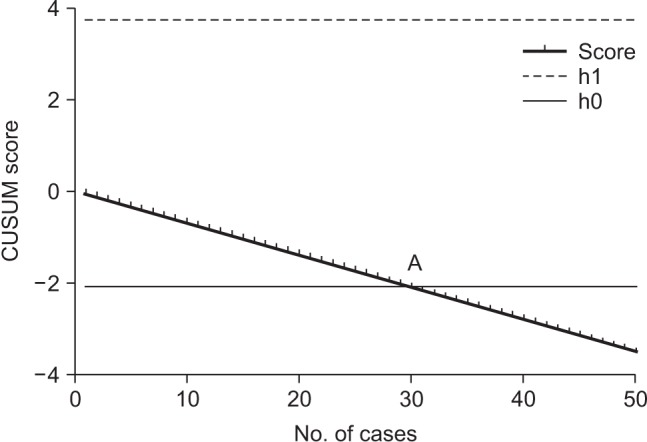Clin Orthop Surg.
2018 Mar;10(1):9-13. 10.4055/cios.2018.10.1.9.
Learning Curve of Internal Fixation for Nondisplaced Femoral Neck Fractures: A Cumulative Sum Analysis
- Affiliations
-
- 1Department of Orthopedic Surgery, Seoul National University Bundang Hospital, Seongnam, Korea. jinwu3911@hanmail.net
- 2Department of Orthopaedic Surgery, Chung-Ang University College of Medicine, Seoul, Korea.
- KMID: 2405476
- DOI: http://doi.org/10.4055/cios.2018.10.1.9
Abstract
- BACKGROUND
The purpose of this study was to determine whether there is a learning curve for internal fixation for nondisplaced femoral neck fractures using the cumulative sum (CUSUM) technique. We applied the CUSUM technique in monitoring performance of a single surgeon in internal fixation for nondisplaced femoral neck fractures.
METHODS
Fifty consecutive patients who underwent internal fixation for nondisplaced femoral neck fractures were evaluated retrospectively. Loss of fixation within 6 months postoperatively was considered as failure of treatment. Patients were stratified into the early experience group (cases 1 to 25) and the late experience group (cases 26 to 50). The CUSUM method was used to analyze the learning curve.
RESULTS
There was no failure of treatment during study period. The operation time became shorter with experience. Using the CUSUM analysis to plot the learning curve, there was no significant learning curve observed for multiple pinning for nondisplaced femoral neck fractures.
CONCLUSIONS
The CUSUM analysis revealed there was no obvious learning curve to become proficient at internal fixation for nondisplaced femoral neck fractures, if technical principles were followed during the procedure.
MeSH Terms
Figure
Cited by 2 articles
-
“Free Hand” or Wire Guide: To the Editor
Nirmal Kumar Sinha, Amit Bhardwaj
Clin Orthop Surg. 2019;11(4):495-495. doi: 10.4055/cios.2019.11.4.495.“Free Hand” or Wire Guide: In Reply
Young-Kyun Lee, Kyung-Ho Moon, Jin-Woo Kim, Yong-Chan Ha, Myung-Ho Lee, Kyung-Hoi Koo
Clin Orthop Surg. 2019;11(4):496-496. doi: 10.4055/cios.2019.11.4.496.
Reference
-
1. Conn KS, Parker MJ. Undisplaced intracapsular hip fractures: results of internal fixation in 375 patients. Clin Orthop Relat Res. 2004; (421):249–254.2. Lu-Yao GL, Keller RB, Littenberg B, Wennberg JE. Outcomes after displaced fractures of the femoral neck: a meta-analysis of one hundred and six published reports. J Bone Joint Surg Am. 1994; 76(1):15–25. PMID: 8288658.
Article3. Kain MS, Marcantonio AJ, Iorio R. Revision surgery occurs frequently after percutaneous fixation of stable femoral neck fractures in elderly patients. Clin Orthop Relat Res. 2014; 472(12):4010–4014. PMID: 25256623.
Article4. Konan S, Rhee SJ, Haddad FS. Hip arthroscopy: analysis of a single surgeon's learning experience. J Bone Joint Surg Am. 2011; 93(Suppl 2):52–56. PMID: 21543689.
Article5. McCarthy JC, Lee J. Hip arthroscopy: indications and technical pearls. Clin Orthop Relat Res. 2005; 441:180–187. PMID: 16331001.6. McCarthy JC, Lee JA. Hip arthroscopy: indications, outcomes, and complications. Instr Course Lect. 2006; 55:301–308. PMID: 16958465.7. Alho A, Benterud JG, Solovieva S. Internally fixed femoral neck fractures: early prediction of failure in 203 elderly patients with displaced fractures. Acta Orthop Scand. 1999; 70(2):141–144. PMID: 10366914.
Article8. Parker MJ, Raghavan R, Gurusamy K. Incidence of fracturehealing complications after femoral neck fractures. Clin Orthop Relat Res. 2007; 458:175–179. PMID: 17224836.
Article9. Salowi MA, Choong YF, Goh PP, Ismail M, Lim TO. CUSUM: a dynamic tool for monitoring competency in cataract surgery performance. Br J Ophthalmol. 2010; 94(4):445–449. PMID: 19951939.
Article10. Frandsen PA, Andersen E, Madsen F, Skjodt T. Garden's classification of femoral neck fractures: an assessment of interobserver variation. J Bone Joint Surg Br. 1988; 70(4):588–590. PMID: 3403602.
Article11. Okrainec A, Ferri LE, Feldman LS, Fried GM. Defining the learning curve in laparoscopic paraesophageal hernia repair: a CUSUM analysis. Surg Endosc. 2011; 25(4):1083–1087. PMID: 20835725.
Article12. Jaffer U, Cameron AE. Laparoscopic appendectomy: a junior trainee's learning curve. JSLS. 2008; 12(3):288–291. PMID: 18765054.13. Axelrod DA, Guidinger MK, Metzger RA, Wiesner RH, Webb RL, Merion RM. Transplant center quality assessment using a continuously updatable, risk-adjusted technique (CUSUM). Am J Transplant. 2006; 6(2):313–323. PMID: 16426315.
Article14. Kestin IG. A statistical approach to measuring the competence of anaesthetic trainees at practical procedures. Br J Anaesth. 1995; 75(6):805–809. PMID: 8672339.
Article15. Sikorski JM, Barrington R. Internal fixation versus hemiarthroplasty for the displaced subcapital fracture of the femur: a prospective randomised study. J Bone Joint Surg Br. 1981; 63(3):357–361. PMID: 7263746.
Article16. Bray TJ, Smith-Hoefer E, Hooper A, Timmerman L. The displaced femoral neck fracture: internal fixation versus bipolar endoprosthesis. Results of a prospective, randomized comparison. Clin Orthop Relat Res. 1988; (230):127–140.
- Full Text Links
- Actions
-
Cited
- CITED
-
- Close
- Share
- Similar articles
-
- Postoperative Valgus Deformity and Progression of Ostheoarthritis in Non-Displaced Femoral Neck Fractures
- Clinical Results of Dual SC Screw: A Mini-Sliding Hip Screw with an Anti-rotating Screw for Femoral Neck Fractures
- Cumulative Sum Analysis of the Learning Curve of Free Flap Reconstruction in Head and Neck Cancer Patients
- The Significance of Posterior Cortex in Complicated Femoral Neck Fractures which were Internal Fixated
- Classification of Femoral Neck Fractures


